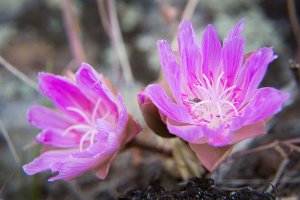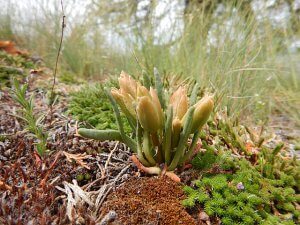Introducing Bitterroot
Lewisia rediviva is known commonly as Bitterroot, a plant that is a part of the Montiaceae family and that is native to western North America. Originally, this plant was a member of the Purslane family due to its growth requirements and succulent-like appearance but was later categorized. Bitterroot is also known by several alternative names, including black medicine, spetium, and gentian.
Bitterroot is a small, perennial plant that grows bests in areas found in low and mid-range elevations. You can often spot bitterroot growing in grasslands, bushland, and forests. Bitterroot will also thrive in rocky or gravel-like, dry soil, as the plant is known for its ability to regenerate, even when the root system is seemingly dry and dead.
Bitterroot is commonly found in locations, such as British Columbia through Washington and Oregon. Then, west of Cascade Range to southern California, and eastern to western Montana and Wyoming, as well as northern Colorado and Arizona. The bitterroot plant is even the official state flower of Montana.
This flower blooms between May and June, and can be found most commonly in a pink-purple color, but also in white. Bitterroot is known by its name because of its two main characteristics: its main taproot system and of having a bitter taste. The taproot may have one single base or have branches that stem off of the main base. The stems on the Bitterroot flower are leafless and can reach between one and three centimeters tall, with a single flower that blooms at the end of each stem. Each flower has between five and nine oval-shaped petals. Once the plant reaches maturity, bitterroot will produce egg-shaped seeds, anywhere from six to 20 at a time.

History of Bitterroot
The scientific name, Lewisia rediviva, stems from when bitterroot was officially discovered by Meriweather Lewis, of the Lewis and Clark Expedition. Yet, bitterroot has been used in many tribes and native cultures before the said expedition. Tribes that are known to have used and eaten bitterroot include the Shoshone, Bitterroot Salish, and the Lakota Sioux. Although too bitter for the Europeans taste, tribes consumed the root as a delicacy.

How to Use Bitterroot
The primary part that is used from this plant is the root. The root has been used for centuries by native tribes and has been noted not to be enjoyed by Europeans at the time due to the bitter flavor, but the roots can be eaten raw or cooked. The root can be peeled, then boils, and made into a jelly-like food. The Ktunaxa tribe preferred to cook their Bitterroot with grouse, then eaten with sugar, whereas other tribes preferred to use salt.
Bitterroot historically has been used for a variety of ailments, and not only as a food resource. Hence the plant’s alternative name, black medicine, bitterroot has been used to improve heart health, ease inflammation and nerves, aid in skin conditions, and help to maintain and detoxify the body. When consumed, bitterroot has been used as a means to dilate blood vessels to prevent hearts attacks and strokes, as well as relieving general aches of the body. Bitterroot might also aid in maintaining blood sugar levels and in providing stomachache relief.

Summary of Bitterroot
Although this plant is rich in cultural history, the plant is not found to be nutritionally rich. However, some have reported strong effects after consuming bitterroot, so it is best to start small in foraging and using this plant. Although harvesting bitterroot may not be the most filling option in the diverse world of foraging plants, it might be still one to consider in connecting with nature and North America’s heritage as a whole.
—————Written by Jordyn Lee
Jordyn Lee is a freelance writer with a background in herbalism and a passion for sustainable living. She has a Bachelor's degree in Communication Studies and continues to learn more about health and nature. Connect with her on (LinkedIn) or Freelancer Profile (upwork.com).
Many of our readers find that subscribing to Eat The Planet is the best way to make sure they don't miss any of our valuable information about wild edibles.
See our privacy policy for more information about ads on this site






